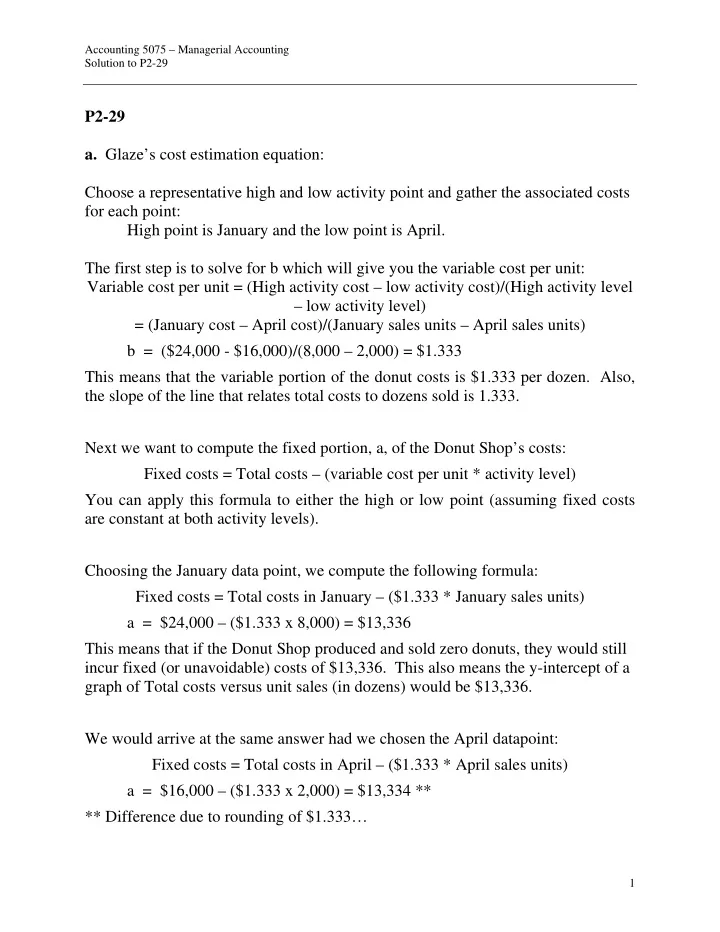

Accounting 5075 – Managerial Accounting Solution to P2-29 P2-29 a. Glaze’s cost estimation equation: Choose a representative high and low activity point and gather the associated costs for each point: High point is January and the low point is April. The first step is to solve for b which will give you the variable cost per unit: Variable cost per unit = (High activity cost – low activity cost)/(High activity level – low activity level) = (January cost – April cost)/(January sales units – April sales units) b = ($24,000 - $16,000)/(8,000 – 2,000) = $1.333 This means that the variable portion of the donut costs is $1.333 per dozen. Also, the slope of the line that relates total costs to dozens sold is 1.333. Next we want to compute the fixed portion, a, of the Donut Shop’s costs: Fixed costs = Total costs – (variable cost per unit * activity level) You can apply this formula to either the high or low point (assuming fixed costs are constant at both activity levels). Choosing the January data point, we compute the following formula: Fixed costs = Total costs in January – ($1.333 * January sales units) a = $24,000 – ($1.333 x 8,000) = $13,336 This means that if the Donut Shop produced and sold zero donuts, they would still incur fixed (or unavoidable) costs of $13,336. This also means the y-intercept of a graph of Total costs versus unit sales (in dozens) would be $13,336. We would arrive at the same answer had we chosen the April datapoint: Fixed costs = Total costs in April – ($1.333 * April sales units) a = $16,000 – ($1.333 x 2,000) = $13,334 ** ** Difference due to rounding of $1.333… 1
Accounting 5075 – Managerial Accounting Solution to P2-29 P2-29 (cont.) Putting it together, we want to find parameters for the equation: Y = a + bX Y = $13,336 + $1.333(sales in dozens) b. Plot of equations and observations: Total Monthly Cost New Line $30,000 Total Monthly Cost $25,000 $20,000 Old Line $15,000 $10,000 $5,000 $0 0 2000 4000 6000 8000 1000 0 Monthly Sales (dozens) A review of the scatter diagram, indicates the April unit volume is not representative. Revising the cost estimating equation with the more representative January and March volumes: b = ($24,000 - $17,000)/(8,000 – 4,500) = $2.00 a. = $24,000 – (8,000 x $2.00) = $8,000 Y = $8,000 + $2.00(sales in dozens) Notice that the slope of the new line is higher (2.00 > 1.333) which means that variable costs per dozen donuts are now estimated to be higher, but fixed costs are estimated to be lower ($8,000 < $13,336). 2
Accounting 5075 – Managerial Accounting Solution to P2-29 P2-29 (cont.) c. Which is a better predictor of future costs? Why? The representative values identified with the aid of a scatter diagram provide a better cost estimating equation and better predictor of future costs. This is because it omits the outlier observation at a volume of 2,000 units. The April observation represented unusually low activity and should be not used in the estimation to predict future costs. However, if April has a recurring seasonal characteristic, we would want to incorporate that knowledge into forecasts of future costs for the month of April in any given year. d. If you decided to develop a cost estimating equation using the method of least squares, should you include all the observations? Why or why not? No. I would omit the observation for 2,000 units because it does not appear representative of normal operating conditions. e. Reasons why the least-squares method is superior to the high-low and scatter diagram methods of cost estimation include. • It is objective. • It provides a measure of how well the cost estimating equation explains the variation in the dependent variable (the R-squared statistic). 3
Recommend
More recommend